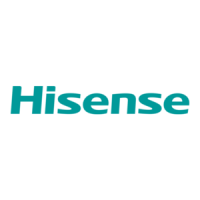
Do you have a question about the Hisense HCPC-H2M1C and is the answer not in the manual?
Crucial safety guidelines for product installation, operation, and maintenance.
Safety precautions related to product installation and electrical wiring procedures.
Guidelines for safely repairing and moving the product to prevent hazards.
General cautionary notes covering operation, wiring, and product usage.
Specific instructions and warnings for product installation, including placement.
Essential safety measures and prohibitions for connecting wires to the product.
Guidelines on suitable environments and conditions for product operation.
Procedures for inspecting the product upon arrival to check for damages and completeness.
Illustrates the overall system architecture and connectivity of the Modbus adapter.
Details the names and locations of various parts and connectors on the Modbus adapter.
Identifies specific components like LEDs, switches, and connectors on the adapter.
Lists hardware and communication specifications for the Modbus adapter.
Criteria for choosing a suitable location to install the Modbus adapter.
Step-by-step instructions for physically installing the Modbus adapter.
Guidelines and procedures for connecting the adapter to power and communication lines.
Configuration of slide switches for different operational modes and circuit settings.
Instructions for connecting the power supply and understanding indicator lights.
Initial setup of the adapter for PC communication.
Procedures for configuring the adapter's IP address via LAN or WIFI.
Instructions for setting the real-time clock using keys or the WEB server.
Procedure to change the password for accessing the LAN WEB interface.
Procedure to change the password for accessing the wireless WEB interface.
Method to reset the adapter to factory default settings via a single key press.
Configuration of the IP address and port for the remote server.
Procedures for setting the subnet mask for network communication.
Steps to configure the gateway IP address for network access.
Guidance on formatting and using an SD card for data storage.
Information on using external input and output signals for linkage functions.
Procedure for logging in a single board constant speed machine.
How to check and verify the adapter's MAC address.
Analysis of Modbus TCP and RTU code structures and frames.
How to set control bits for various indoor unit functions like run/stop and fan speed.
Procedure to clear the filter status for indoor units.
Configuring specific function selections for indoor units.
Settings for prohibiting wire controller functions (all or partial).
Default status and settings for units without a wire controller.
Key settings related to EEPROM clearing and connection states.
Verifying the connection status between outdoor and indoor units.
Reading and monitoring operating data from indoor units.
Using batch commands for controlling multiple indoor units simultaneously.
Method to disable the digital tube alarm display for energy saving.
Troubleshooting guide for common problems like power issues and connection failures.
Routine checks for the surrounding environment, display, and connections.
Considerations for checking control states and data monitoring.
Important notes regarding subnet mask settings and network connectivity.
Limitations and applicability of auto fan speed settings.
Specific notes for AC desiccant units regarding temperature prohibition.
Guidelines for using wire controllers with multiple indoor units.
Precautions when using with other centralized controllers.
Behavior when fan speed or operating mode jumps occur.
Important considerations for setting various unit functions.
Specifics for DC desiccant units regarding setting operations.
Potential issues and confirmations for wire controller installation.
Information about the CRC check method for Modbus RTU.
Considerations for multiple computers managing the adapter via Modbus TCP.
Tips to shorten connection confirmation time.
Recommendation and interface overview of the Modbus Poll tool for debugging.
